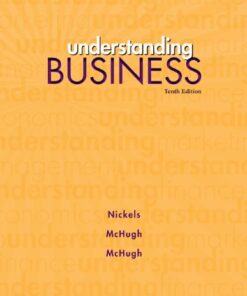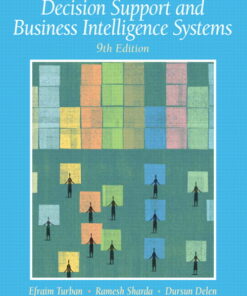Solution Manual for Staffing Organizations 7th Edition by Heneman
$35.00
Solution Manual for Staffing Organizations 7th Edition by Heneman
You will receive this product immediate after placing the order
- The item being sold is not the textbook. This study guide can be used for your university class / college course or online course / online university / edu online, whether you are studying for your bachelor degree or masters degree. Also great for your short summer courses / summer session.
- Please note that the files are compressed using the program Winzip.
- Files ending with the extension (.pdf) can be opened using Adobe Acrobat Reader.
- Files ending with the extension (.doc) (.docx) or (.rtf) can be opened using Microsoft Word Viewer 2007.
CHAPTER 02: Legal Compliance
_____________________________________________________________
Sample Answers for Discussion Questions
1. Do you agree that “the employer usually has the upper hand” when it comes to establishing the employment relationship? When might the employee have maximum power over the employer?
Sample Response: Sometimes the employer has the upper hand, but this must be considered in light of employee actions as well. The employer has control over the creation of the job, the specifications of the job, and the location of the job. The employer also controls access to the job, retention, and termination of the job. The employee has maximum power over the employer when there is short supply of the skill the employee possesses, and the company has a critical need for this same skill. The employer is then in the position of having to offer the job to the prospective employee, probably at a relatively high compensation rate. This short supply can also be created artificially, and en masse when workers go out on strike. This action has the potential of stopping production completely and bringing the company to the brink of bankruptcy, at which point the company may be forced to agree to the employee (i.e., union) terms of employment. On the other hand, the employee can control his or her work effort on the job, can seek to change employment practices internally, or can leave the company whenever he or she wants.
2. What are the limitations of disparate impact statistics as indicators of potential staffing discrimination?
Sample Response: Disparate impact statistics describe existing demographic patterns, but they do not necessarily explain the reasons these patterns exist. The underlying reasons for the patterns may, or may not, be caused by discrimination. There may be cultural and historical reasons for concentrations of categories of people in certain jobs. For example, the historical role of women is still affecting the concentration by gender that can be observed in certain jobs. Until fairly recently, most women remained at home as full-time mothers and housewives. And, when women did work, they were discouraged from seeking jobs that required manual labor or heavy physical exertion. Such physically stressful work was not considered “lady-like”. To this day, relatively few women are applying for jobs as forklift truck drivers or welders. Admittedly, these so-called cultural norms involved discrimination, but their historical significance in establishing patterns has still not been overcome. It is still culturally unacceptable for men to assume jobs as secretaries, which have traditionally been considered “female-jobs”. There is a similar bias towards jobs as elementary school teachers, which are dominated by women. In cases such as these, it is unlikely that either AA measures or quotas would resolve the disparities in concentration of jobs. Men would not change their frequency of either seeking or accepting jobs traditionally considered “female” for historical, cultural reasons.
There can also be patterns attributable to age or socio-economic class. For example, few middle-aged white, Anglo-Saxon males are likely to work as fast-food waiters or gardeners. These jobs are not considered suitable for primary wage earners and are held respectively by teenagers and foreign nationals in disproportionate numbers. There are also disparities due to indirect forms of discrimination; that is, discrimination other than hiring discrimination, that impacts on the ability to hire. For example, residential housing patterns are impacted by convert segregation and economic disparities between the races. Accordingly, members of one race do not, or cannot afford economically, to work in certain sections of cities dominated by another race. The point is not that these demographic patterns are desirable, acceptable, or just. In many cases they are not. But, they exist and they are not always susceptible to legislative or regulatory correction in the short term.
3. Why is each of the four situational factors necessary to establishing a claim of disparate impact?
Sample Response: The first factor is that of belonging to a protected class. This factor is necessary because there has to be a rationale that a given class of people has been discriminated against in the past in order for a given anti-discrimination statute to have legal relevance.
The second factor is for the person to have applied for, and been qualified for, a job the employer was trying to fill. Unless someone has tried to apply for a job, there is no possibility of demonstrating that the “intent to discriminate” rule has been violated, and disparate treatment hinges on this “intent” factor.
The third factor is having been qualified, but having been rejected for a job despite being qualified. Rejection must take place because one could hardly prove discrimination in a court of law if the plaintiff had been offered the job. The “qualified” factor is important because, if the person was not qualified, then the employer can justify having not hiring the person for factors “reasonably” related to the special nature of the job. In other words, the employer has a viable affirmative defense for failing to hire the plaintiff.
The fourth factor is that the position has remained open after the qualified individual was rejected, and the employer continued to seek other candidates with similar qualifications. This factor makes it possible to establish prima facie evidence that the employer elected “intentionally” not to hire a person who is qualified for the job. Unless the employer can present a satisfactory rebuttal, discrimination has been proved in the eyes of the law and the employer will be held liable.
4. What factors would lead an organization to enter into a consent agreement rather than continue to pursue a suit in court?
Sample Response: There are many economic reasons why an organization might enter into a consent agreement. One of these is the extent of the liability for either continuing the suit or losing the suit altogether. Suits are expensive in terms of damages awarded to plaintiffs, management time lost in attending to the suit, and legal costs. An organization may wish to minimize all of these costs through a consent agreement.
There are other repercussions that can occur as a result of suits. If the magnitude of the potential liability is large and will continue to escalate this liability can be viewed by the financial community as a negative, and can effect the price of an organization’s stock or its ability to raise money on reasonable terms in the capital markets.
There is also the question of an organization’s public image. Organizations with the negative image associated with discrimination can have trouble attracting customers and/or employees, especially managerial employees. These eventualities can threaten the future financial and operational viability of the organization.
5. What are the differences between staffing in the private and public sectors? Why would private employers probably resist adopting many of the characteristics of public staffing systems?
Sample Response: Public sector staffing is shaped by the “merit principles” and civil service laws and regulations. These regulations place the public organization under more constraints, more bureaucratic red tape, more outside control, and greater standards of accountability. The public organization is under greater obligation to advertise all job vacancies, open up the application and selection processes to all interested parties, and restrict testing only to certain criteria such as KSAOs. There is a more elaborate system for all phases of the hiring process, and the rights of applicants to appeal hiring decisions are far more liberal than would be the case for private organizations.
Private organizations resist many of these public staffing procedures because of their costs in terms of management time, paperwork, processing costs, and expenses to ensure compliance. This last point could involve, for example, interviewing greater numbers of people, with a consequent increase in costs for travel and transportation. Also, in a sense, private organizations do want to discriminate at times in the staffing process. There are many characteristics of individuals that are not reducible to description on application forms and job descriptions. It is often necessary to rely on personal judgment in assessing such factors as motivation, interpersonal skills, leadership ability, honesty, integrity, and commitment to the job. It is quite possible, even probable, that two individuals might rate the same on paper instruments used in the staffing process and be vastly different when rated judgmentally. Private organizations do not want to be locked into an exclusively bureaucratic, objective process in making decisions on people, the most critical factor to organizational success.
Sample Answers for Ethical Issues
Issue 1
Assume that you’re the staffing manager in a company that informally, but strongly, discourages you and managers from hiring people with disabilities. The company’s rationale is that people with disabilities are unlike to be high performers or long term employees, and are costly to train, insure, and integrate into the work unit. What is your ethical assessment of the company’s stance; do you have an ethical obligation to try to change the stance, and if so, how might you go about that?
Many organizations have tacit policies of discrimination that are not openly communicated but that are known to most managers. In this case, the organization’s position is generally ethically (and legally) unjustifiable. The ethical imperative for an organization is to hire individuals on the basis of their qualifications, so if a disabled individual is truly unable to perform the job, they need not be hired, but if they are capable of performing core work tasks, the organization should make accommodations. Students may differ in their opinion regarding the ethics of resisting the policy, but one who is in a position of making important staffing decisions should probably make some effort to correct the situation. Examples of effective techniques for influence include finding ways to demonstrate to senior managers that disabled individuals are capable of doing the required work, providing senior managers with information regarding the legal ramifications of this informal policy, and also, if these techniques are not effective, refusing to comply with an unjust policy.
Issue 2
Assume the company you work for practices strict adherence to the law in its relationships with employees and job applicants. The company calls it “staffing by the book.” But beyond that, it feels that “anything goes” in terms of tolerated staffing practices. What is your assessment of this approach?
This approach may be effective in generating profits for an organization in the short run, but it may create negative externalities in terms of the organization’s reputation. Companies that enact cutthroat employment policies that fail to recognize the ethical implications of the relationship between an organization and its employees often find that their ability to attract and retain top quality applicants is compromised. It is also often the case that legal strictures on organizations become problematic only when they are treated as a problem—creative organizations learn to use the law to their advantage by incorporating features of ethical compliance into their corporate culture.
Be the first to review “Solution Manual for Staffing Organizations 7th Edition by Heneman” Cancel reply
Related products
Solution Manual
International Accounting Doupnik 4th Edition Solutions Manual
Solution Manual
Understanding Business Nickels 10th Edition Solutions Manual












Reviews
There are no reviews yet.